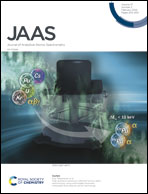Quantification of anthropogenic TiO2 nanoparticles in soils and sediments combining size fractionation and trace element ratio
Abstract
Soils and sediments are the most important sinks for anthropogenic TiO2 nanoparticles. Therefore, it is important to assess their environmental impact and monitor their concentration in these media. Since these matrices contain a high level of natural TiO2, the detection limit for anthropogenic TiO2 nanoparticles depends mostly on the level and heterogeneity of this background, which can be particularly high. In order to tackle this challenge, we explored the potential of combining colloidal extraction and background correction using element ratio (Ti/Nb and Ti/V) to lower the limit of detection at environmentally relevant levels. For that, we spiked one sand, one sediment and two soils, with P25 TiO2 and used them to test the performance of each step of the procedure. Our results show that sample homogenization through grinding, using Nb as a proxy for natural TiO2, and matrix specific recovery correction using standard addition result in limits of detection close to 10 μg (TiO2) per g. Repeating the extraction step and combining the extracts can improve the low recoveries for the extraction step. Interestingly, the natural Ti/Nb ratio is not uniform over the size distribution. This may have implications for the choice and the treatment of the control sample.



 Please wait while we load your content...
Please wait while we load your content...